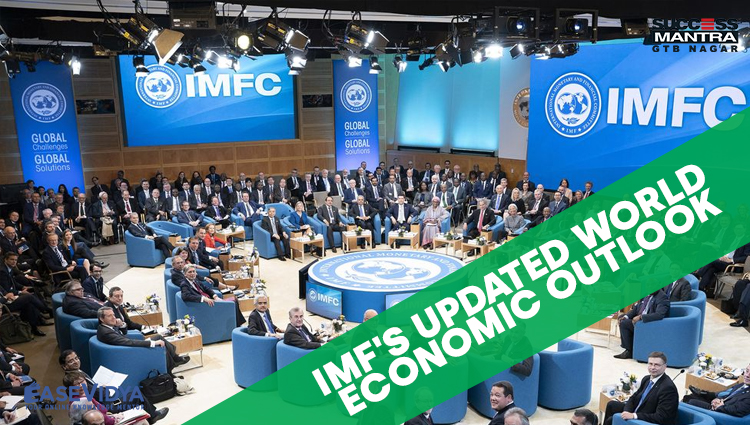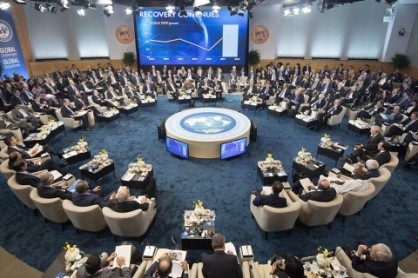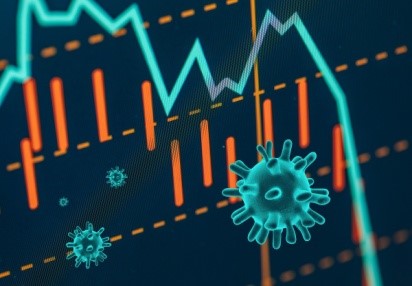
UPDATED WORLD ECONOMIC OUTLOOK OF IMF
IMF'S UPDATED WORLD ECONOMIC OUTLOOK
The International Monetary Fund (IMF) on January 26, 2021 revised its gross domestic product (GDP) projections upward for the current fiscal year and FY 2022 in its forecast update submitted to the World Economic Outlook report. In its updated forecast, the IMF has predicted India's economy to contract narrowly by 8 percent in the current financial year in comparison to the earlier projected contraction of 10.3 percent. The International body has further projected India to report a double-digit expansion in FY 2022. India is predicted to grow by 11.5% in 2021-22 and 6.8% in 2022-23 as the economy shows signs of revival after the arrival of the COVID-19 vaccine and pick-up in economic activity.

ABOUT THE UPDATED PROJECTION
The IMF in its update to the World Economic Outlook (WEO) has projected the world economy to contract by 3.5 percent in 2020 and to recover a little faster and grow at 5.5% in 2021. The IMF has projected India to be the fastest growing major economy for the next two years, displacing China, which is estimated to grow by 8.1% and 5.6% in the next two years. The forecast update also predicts a narrower contraction for the Indian economy in 2020-21 than the previously estimated contraction of 10.3 percent. China is predicted to be the only major economy to post-expansion in 2020, it is expected to grow by 2.3% in the current fiscal year. IMF chief economist Gita Gopinath said at a virtual press conference after the release of the report that the FY21 upgrade for India is because mobility came back much faster than expected. However, she added saying that India is still 9% below its pre-pandemic projection level, cumulating for FY21 and FY22, even after the projected faster bounce back in FY22.
The IMF was set up along with the World Bank after the Second World War to assist in the reconstruction of war-ravaged countries. The two organisations were agreed to be set up at a conference in Bretton Woods in the US. Hence, they are known as the Bretton Woods twins. Created in 1945, the IMF is governed by and accountable to the 189 countries that make up its near-global membership.India joined on December 27, 1945. The IMF's primary purpose is to ensure the stability of the international monetary system.
INDIA'S SPECIFIC PROJECTION
• FY 2020-21: For the current fiscal, the IMF had forecast a record 10.3% contraction.
• FY 2021-22: For the next fiscal, starting from April 1st, GDP growth projection is at 11.5%, 2.7% higher than the projection made in October, 2020.
• Last October, the IMF had projected an 8.8% real GDP growth for India in FY 2021-22, highest globally.
• FY 2022-23: In FY 2022-23, the economy will likely grow 6.8%.
• Governments Projection for 2020-21: The latest revision for the current fiscal is higher than the government’s first advance estimate of 7.7% and also the RBI’s estimate of 7.5%.
• Reason for Increase in the Estimates by IMF: India has taken very decisive action, very decisive steps to deal with the pandemic and to deal with the economic consequences of it.
GOVERNMENT MEASURES TO DEAL WITH THE PANDEMIC
• Pradhan Mantri Garib Kalyan Yojana: The government announced Rs 1.70 lakh crore relief package under the newly framed Pradhan Mantri Garib Kalyan Yojana for the poor to help them fight the battle against covid-19. The central government’s package comes a week after Kerala first announced a Rs 20,000-crore support for its people. Many states including Uttar Pradesh, Uttarakhand, Punjab, Telangana and Rajasthan followed suit.
• Reserve Bank of India’s Covid19 Economic Relief Package: After the Government’s announcement of Pradhan Mantri Gareeb Kalyan Yojana, the Reserve Bank of India’s Monetary Policy Committee (MPC) has come out with its own measures to help deal with economic fallout of COVID-19 pandemic. This was the first time that the MPC met outside its bi-monthly meeting calendar. According to the International Monetary Fund (IMF) chief Kristalina Georgieva, the world has entered a recession that will be worse than the one in 2009, following the global financial crisis. Recession implies significant decline in general economic activity.
• Atmanirbhar Bharat Abhiyan (or Self-reliant India Mission): The Self-Reliant India Mission aims towards cutting down import dependence by focussing on substitution while improving safety compliance and quality goods to gain global market share. Government announced liquidity measures for businesses, especially Micro, Small and Medium enterprises (MSMEs) under the Atmanirbhar Bharat Abhiyan.
GLOBAL PROJECTION ON ECONOMY

Global Economy: The global economy is projected to grow 5.5% in 2021 and 4.2% in 2022. The IMF also saw a narrower 3.5% contraction in world output in 2020 as opposed to a 4.4% decline seen earlier. It attributed the 0.3% point upward revision for 2021 to “expectations of a vaccine-powered strengthening of activity later in the year and additional policy support in a few large economies.
Global Trade Volumes: They are forecasted to grow about 8% in 2021. The IMF expects oil prices to rise in 2021 by just over 20% from the low base for 2020 but they will still remain well below their average for 2019. Non-oil commodity prices are also expected to increase with those of metals, in particular, projected to accelerate strongly in 2021.
Other Economies with High percentage of Growth: China would grow 8.1% in 2021, followed by Spain (5.9%) and France (5.5 %). China, which was the only major country to register a growth rate of 2.3 % in 2020, will expand 5.6% in 2022.
Increased Inequality: The report highlighted the pandemic-induced acceleration in inequality by reiterating that close to 90 million people are likely to fall below the extreme poverty threshold during 2020-21 as workers with less education, women, youth, those in contact-intensive sectors, and those informally employed suffer disproportionate livelihood and income losses. The pandemic is expected to reverse the progress made in poverty reduction across the past two decades. It can be noted that recently, the Inequality Virus Report, released by Oxfam International, has also found that the Covid pandemic deeply increased the existing inequalities in India and around the world.












0 Comment